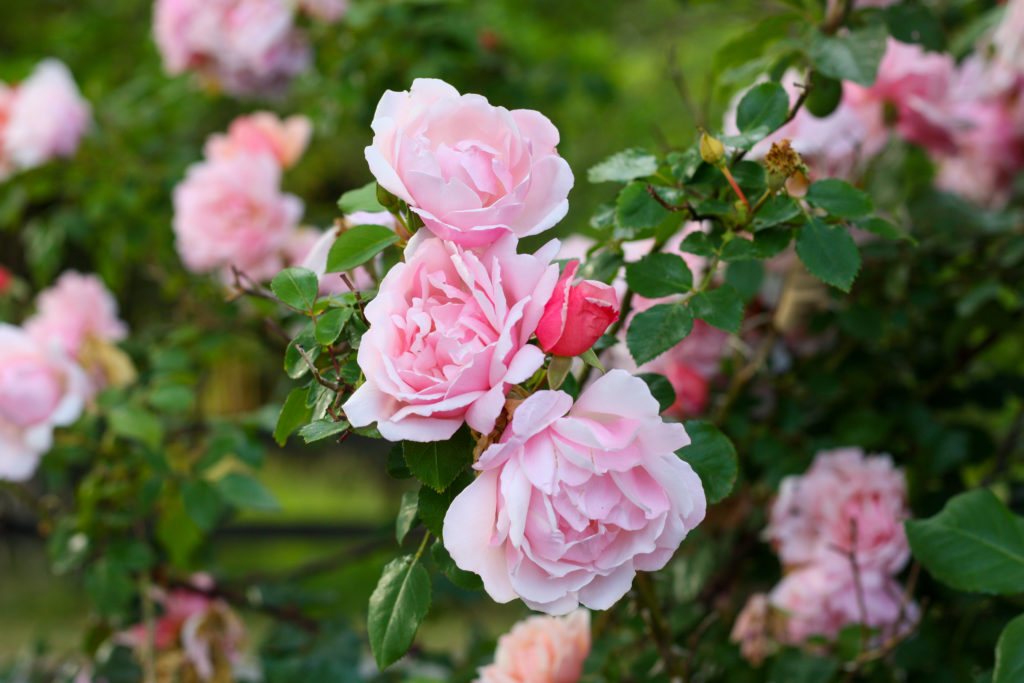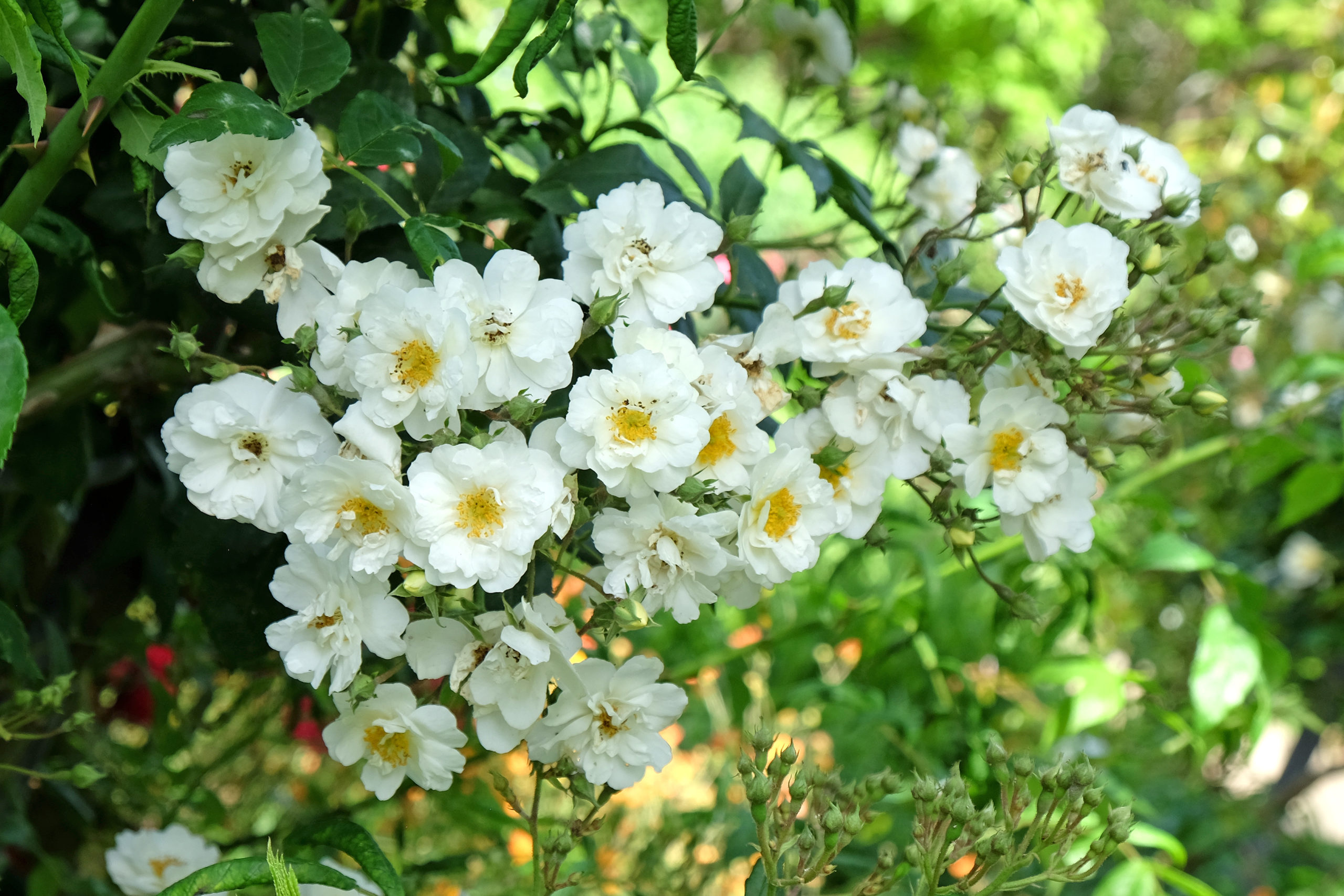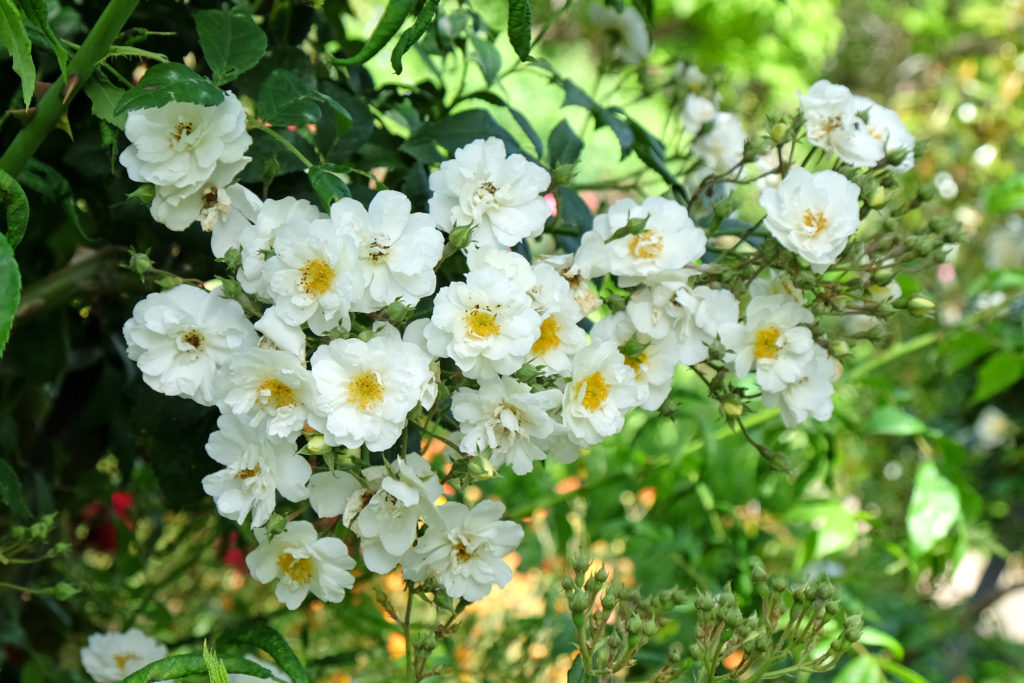Rambling roses are vigorous, fast-growing roses known for their ability to cover large areas with cascades of blooms. Unlike climbing roses, which have a more restrained and repeat-flowering habit, rambling roses tend to produce a single spectacular flush of flowers in early to mid-summer, often followed by ornamental rose hips in autumn. Their long, flexible stems allow them to weave through trees, climb over pergolas, and soften fences or walls, creating a breathtaking display of colour and fragrance.
Typically, rambling roses have smaller flowers than climbers, but they appear in abundant clusters, covering the plant in a cloud of blossoms. Many varieties are highly fragrant and have an informal, wild appearance, making them ideal for cottage gardens, woodland settings, and naturalistic plantings. They are generally low-maintenance and, once established, require little intervention aside from occasional pruning to keep them under control.

Common Types of Rambling Roses
There are many stunning rambling rose varieties, each offering unique characteristics in terms of flower colour, size, and fragrance. Some of the most popular and reliable include:
- ‘Rambling Rector’ – A highly vigorous rambler with clusters of creamy-white flowers that fade to pale pink. This variety is perfect for covering large walls, trees, or pergolas and produces an abundance of rose hips in autumn.
- ‘Albertine’ – One of the most famous ramblers, this variety boasts beautifully scented, coppery-pink flowers with a ruffled appearance. It is ideal for growing over archways and trellises, where its strong fragrance can be enjoyed.
- ‘Paul’s Himalayan Musk’ – A spectacular pale pink rambler that produces thousands of tiny, fragrant flowers in large clusters. This variety is excellent for scrambling through trees or covering unsightly structures.
- ‘The Albrighton Rambler’ – A more manageable rambler developed by David Austin, this variety produces soft pink, fully double flowers with a gentle fragrance. It is repeat-flowering, making it a great choice for smaller gardens.
- ‘Veilchenblau’ – An unusual rambler with violet-purple, semi-double flowers that fade to lilac and have a sweet fragrance. This variety is nearly thornless and is perfect for those looking for a unique addition to their garden.
- ‘Félicité Perpétue’ – A delicate, creamy-white rambler with small, fully double flowers and glossy evergreen foliage. It is ideal for training along fences and walls.
Caring for Rambling Roses
Rambling roses are generally easy to grow and require little maintenance once established. They thrive in full sun but can also tolerate partial shade, making them suitable for growing up trees or in north-facing positions. They prefer fertile, well-drained soil enriched with organic matter such as compost or well-rotted manure at the time of planting.
Watering is essential, particularly in the first year after planting, to help the plant establish strong roots. Once mature, rambling roses are relatively drought-tolerant, though they benefit from occasional deep watering during prolonged dry spells. A thick layer of mulch applied in spring helps retain moisture, suppress weeds, and nourish the soil.
Pruning is one of the key differences between rambling roses and climbing roses. Since most ramblers flower on the previous year’s growth, they should be pruned immediately after flowering in late summer. The oldest and weakest stems should be cut back to ground level to encourage new, vigorous shoots. Lateral branches can be lightly trimmed to maintain shape, and any unwanted growth can be removed to keep the rose in check.
Unlike many other roses, ramblers are generally resistant to common diseases such as black spot and powdery mildew. However, it is still advisable to ensure good air circulation around the plant by spacing them well and removing any congested growth. Occasional pest problems such as aphids can be managed by encouraging natural predators like ladybirds or by using organic insecticidal sprays if necessary.
Ways to Use Rambling Roses in the Garden
Rambling roses are one of the most spectacular ways to add vertical interest and romantic charm to a garden. Their fast growth and abundant flowering make them perfect for covering large structures, hiding unsightly fences, or softening walls and buildings. One of the most effective ways to use them is by training them over a pergola or archway, where their cascading blooms create a stunning overhead display. Their strong fragrance makes walking beneath them an unforgettable sensory experience.
Another beautiful use for rambling roses is allowing them to scramble through trees. This creates a naturalistic and wild effect, as the roses weave through the branches and provide a breathtaking display of flowers in summer, followed by rose hips in autumn. This method works particularly well in woodland gardens or informal settings where a more relaxed planting style is desired.
Ramblers are also excellent for covering fences and walls, adding softness and colour to hard surfaces. They can be trained along horizontal wires or left to grow freely for a more natural appearance. White or pastel-coloured ramblers, such as ‘Félicité Perpétue’ or ‘Rambling Rector,’ create a particularly beautiful contrast against brick or stone walls.
For those looking to create a wildlife-friendly garden, rambling roses are a fantastic choice. Their dense growth provides shelter for birds, while their flowers attract bees and butterflies. Varieties that produce hips, such as ‘Rambling Rector’ and ‘Paul’s Himalayan Musk,’ provide a valuable food source for birds in autumn and winter, making them an excellent addition to a wildlife-focused planting scheme.
While rambling roses are often associated with large gardens, they can also be used in smaller spaces if carefully selected. More compact ramblers such as ‘The Albrighton Rambler’ can be trained along a trellis or small arch, providing all the beauty of a traditional rambler without overwhelming the space.
For a truly romantic and timeless effect, rambling roses can be paired with other climbers, such as clematis or honeysuckle. The combination of different flower shapes and colours creates a layered, visually stunning display that lasts throughout the summer. By selecting varieties with staggered flowering times, it is possible to extend the floral display well beyond the typical rambling rose bloom period.
With their vigorous growth, breathtaking flowers, and versatility in the garden, rambling roses are a must-have for those looking to add height, drama, and natural beauty to their outdoor spaces. Whether used to adorn a pergola, climb through trees, or provide a riot of colour along a fence, these roses bring an enchanting and traditional charm to any landscape.


